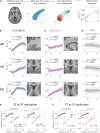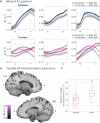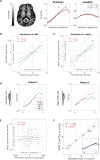Mapping microstructural gradients of the human striatum in normal aging and Parkinson's disease
- PMID: 35857492
- PMCID: PMC9286505
- DOI: 10.1126/sciadv.abm1971
Mapping microstructural gradients of the human striatum in normal aging and Parkinson's disease
Abstract
Mapping structural spatial change (i.e., gradients) in the striatum is essential for understanding the function of the basal ganglia in both health and disease. We developed a method to identify and quantify gradients of microstructure in the single human brain in vivo. We found spatial gradients in the putamen and caudate nucleus of the striatum that were robust across individuals, clinical conditions, and datasets. By exploiting multiparametric quantitative MRI, we found distinct, spatially dependent, aging-related alterations in water content and iron concentration. Furthermore, we found cortico-striatal microstructural covariation, showing relations between striatal structural gradients and cortical hierarchy. In Parkinson's disease (PD) patients, we found abnormal gradients in the putamen, revealing changes in the posterior putamen that explain patients' dopaminergic loss and motor dysfunction. Our work provides a noninvasive approach for studying the spatially varying, structure-function relationship in the striatum in vivo, in normal aging and PD.
Figures





Similar articles
-
Spatial remapping of cortico-striatal connectivity in Parkinson's disease.Cereb Cortex. 2010 May;20(5):1175-86. doi: 10.1093/cercor/bhp178. Epub 2009 Aug 26. Cereb Cortex. 2010. PMID: 19710357
-
Uneven age effects of [(18)F]FP-CIT binding in the striatum of Parkinson's disease.Ann Nucl Med. 2014 Nov;28(9):874-9. doi: 10.1007/s12149-014-0882-1. Epub 2014 Jul 10. Ann Nucl Med. 2014. PMID: 25008292
-
Subregional analysis of striatum iron in Parkinson's disease and rapid eye movement sleep behaviour disorder.Neuroimage Clin. 2023;40:103519. doi: 10.1016/j.nicl.2023.103519. Epub 2023 Sep 28. Neuroimage Clin. 2023. PMID: 37797434 Free PMC article.
-
Imaging in Parkinson's disease: the role of monoamines in behavior.Biol Psychiatry. 2006 May 15;59(10):908-18. doi: 10.1016/j.biopsych.2005.12.017. Epub 2006 Apr 11. Biol Psychiatry. 2006. PMID: 16581032 Review.
-
Post mortem studies in Parkinson's disease--is it possible to detect brain areas for specific symptoms?J Neural Transm Suppl. 1999;56:1-29. doi: 10.1007/978-3-7091-6360-3_1. J Neural Transm Suppl. 1999. PMID: 10370901 Review.
Cited by
-
Relationship Between Excessive Daytime Sleepiness and Caudate Nucleus Volume in Patients with Subjective Cognitive Decline: A Study from the SILCODE Using the Volbrain.J Alzheimers Dis Rep. 2024 Jun 18;8(1):935-944. doi: 10.3233/ADR-230101. eCollection 2024. J Alzheimers Dis Rep. 2024. PMID: 39114552 Free PMC article.
-
Relative sparing of dopaminergic terminals in the caudate nucleus is a feature of rest tremor in Parkinson's disease.NPJ Parkinsons Dis. 2024 Nov 18;10(1):209. doi: 10.1038/s41531-024-00818-8. NPJ Parkinsons Dis. 2024. PMID: 39557871 Free PMC article.
-
Radiomics score derived from T1-w/T2-w ratio image can predict motor symptom progression in Parkinson's disease.Eur Radiol. 2024 Dec;34(12):7921-7933. doi: 10.1007/s00330-024-10886-2. Epub 2024 Jul 3. Eur Radiol. 2024. PMID: 38958697
-
Mapping striatal functional gradients and associated gene expression in Parkinson's disease with continuous cognitive impairment.NPJ Parkinsons Dis. 2025 May 28;11(1):138. doi: 10.1038/s41531-025-01002-2. NPJ Parkinsons Dis. 2025. PMID: 40425604 Free PMC article.
-
Visualizing alpha-synuclein and iron deposition in M83 mouse model of Parkinson's disease in vivo.Brain Pathol. 2024 Nov;34(6):e13288. doi: 10.1111/bpa.13288. Epub 2024 Jul 9. Brain Pathol. 2024. PMID: 38982662 Free PMC article.
References
-
- Cass W. A., Grondin R., Andersen A. H., Zhang Z., Hardy P. A., Hussey-Andersen L. K., Rayens W. S., Gerhardt G. A., Gash D. M., Iron accumulation in the striatum predicts aging-related decline in motor function in rhesus monkeys. Neurobiol. Aging 28, 258–271 (2007). - PubMed
-
- Prensa L., Giménez-Amaya J. M., Parent A., Chemical heterogeneity of the striosomal compartment in the human striatum. J. Comp. Neurol. 413, 603–618 (1999). - PubMed
MeSH terms
LinkOut - more resources
Full Text Sources
Medical

